Michigan chestnut update – June 21, 2013
Potato leafhopper nymphs are visible in chestnut orchards. Early developing varieties like ‘Labor Day’ are beginning to shed pollen and female flowers are becoming visible in southern Michigan.
So far this season the East Lansing Enviro-weather station has accumulated 751 GDD50 with 0.44 inches of rain over the past week; the Clarksville Enviro-weather station has recorded 695 GDD50 with 0.74 inches of rain this past week; and the Northwest Michigan Horticultural Research Center has accumulated 572 GDD50 with 0.97 inches of rain over the last week. Catkins with stamens are visible on ‘Labor Day’ in southern Michigan with tiny female flowers becoming visible at the base of catkins. ‘Labor Day’ is a Korean/Japanese cultivar with earlier development than other selections.
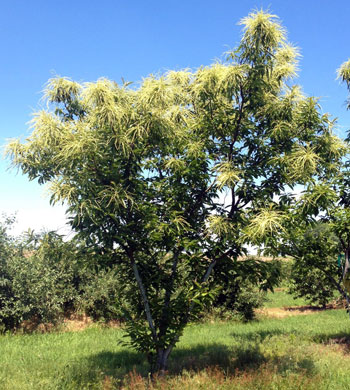
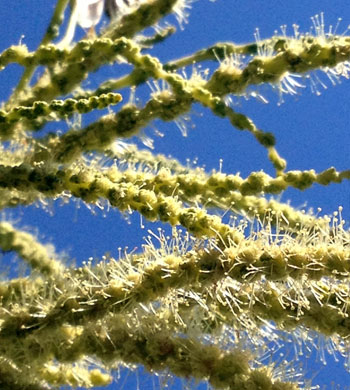
Left, Cultivar ‘Labor Day’ with plentiful male catkins. Right, Close-up of the male catkins showing
the small, hair-like, pollen-bearing stamen. Photo credits: Mario Mandujano, MSU
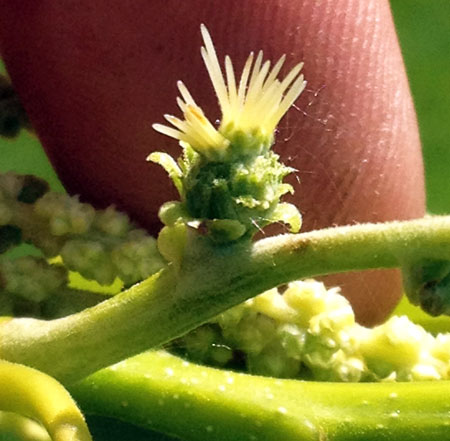
Female flower where a burr will eventually form if pollinated.
Photo credit: Mario Mandujano, MSU
Potato leafhoppers were caught for the third week in a row, and nymphs have been observed. Like many plants, chestnuts are sensitive to the saliva of potato leafhoppers which is injected by the insect while feeding. Damage to leaf tissue can cause reduced photosynthesis which can impact production and quality, and damage the tree. Most injury occurs on new tissue on shoot terminals with potato leafhoppers feeding near the edges of the leaves using piercing-sucking mouthparts. Symptoms of feeding appear as whitish dots arranged in triangular shapes near the edges. Heavily damaged leaves are cupped with necrotic and chlorotic edges and eventually abscise from the tree. Severely infested shoots produce small, bunched leaves with reduced photosynthetic capacity.
Adult leafhoppers are pale to bright green and about 1/8 inch long. Adults are easily noticeable, jumping, flying or running when agitated. The nymphs (immature leafhoppers) are pale green and have no wings, but are very similar in form to the adults. Growers should also walk through their orchards, flipping over leaves and looking for adult potato leafhoppers and nymphs.
The most common classes of insecticides recommended for control of potato leafhoppers include the pyrethroids, carbamates, neonicotinoids and organophosphates. See the additional Michigan State University Extension article, “Potato leafhopper management in chestnuts” for more information. Remember, even growers who believe they may have experienced crop losses due to the frost and freeze events this spring will still need to treat for potato leafhoppers to maintain tree health.
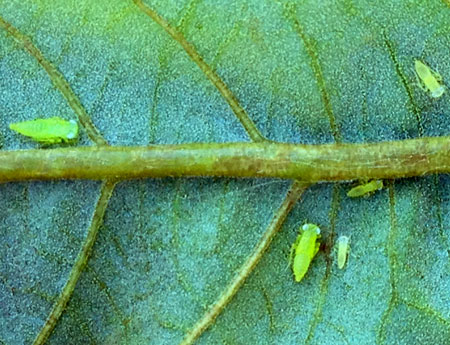
Wingless potato leafhopper nymphs on the back of a chestnut
leaf. Photo credit: Mario Mandujano, MSU
Rose chafers are being reported around the state now. Rose chafers are considered a generalist pest and affect many crops, particularly those found on or near sandy soils or grassy areas. The adult beetles feed heavily on foliage and blossom parts of numerous horticultural crops in Michigan and can cause significant damage to chestnut orchards. Rose chafers can be particularly damaging on young trees with limited leaf area. Like Japanese beetles, rose chafers skeletonize the chestnut leaves, but tend to consume larger pockets of tissue with damage similar to caterpillar feeding than the fine, lace-like leaf that results from Japanese beetle feeding.
Rose chafers are light tan with a darker brown head and long legs and are about 12 millimeters long. There is one generation per year. Adults emerge from the ground during late May or June and live for three to four weeks. They are often found in mating pairs and fly during daylight hours. Visual observation while walking a transect is the best method for locating them. Because of their aggregating behavior, they tend to be found in larger groups and are typically relatively easy to spot.
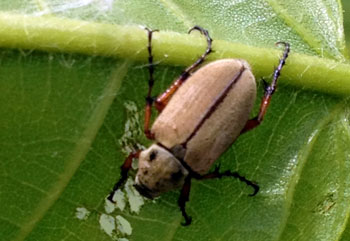
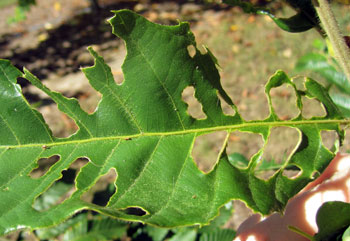
Left, Rose chafer on chestnut. Photo credit: Mario Mandujano, MSU Extension. Right, Typical feeding damage from
rose chafers on chestnut. Photo credit: Erin Lizotte, MSU Extension
There are no established treatment thresholds or data on how much damage a healthy chestnut tree can sustain from rose chafers, but growers should consider that well-established and vigorous orchards will likely not require complete control. Younger orchards with limited leaf area will need to be managed more aggressively.
Managing rose chafers can be a frustrating endeavor as they can re-infest from surrounding areas quickly. This re-infestation is often misinterpreted as an insecticide failure, but efficacy trials have shown that a number of insecticides remain effective treatment options. Carbamate, organophosphate, pyrethroid and neonicotinoid insecticides all have good activity against rose chafers and can provide some control.
Organic options including azadirachtin products and surround are marginally effective. Growers choosing to use kaolin clay should remember that good coverage is key and those considering pyrethroids or neonicotinoids should be aware that these products may potentially increase pest mite populations. Refer to the article “Rose chafer management in chestnuts for 2013“ for more information on rose chafer biology and management.
Dr. Fulbright’s work is funded in part by MSU‘s AgBioResearch.



 Print
Print Email
Email



